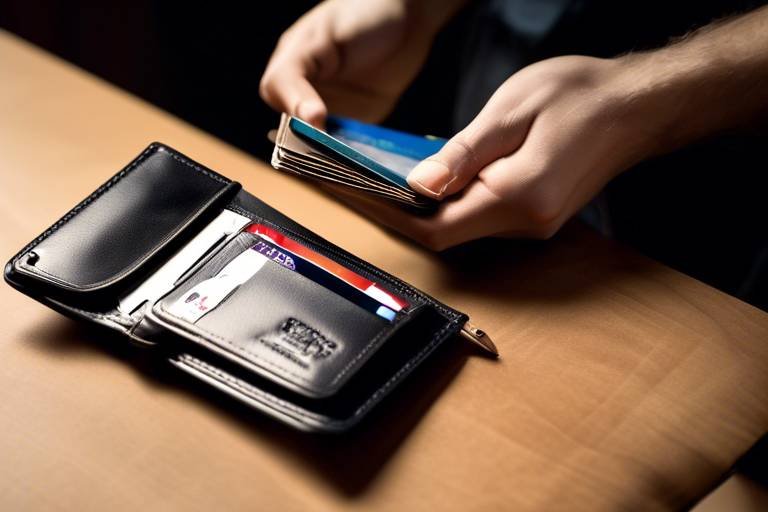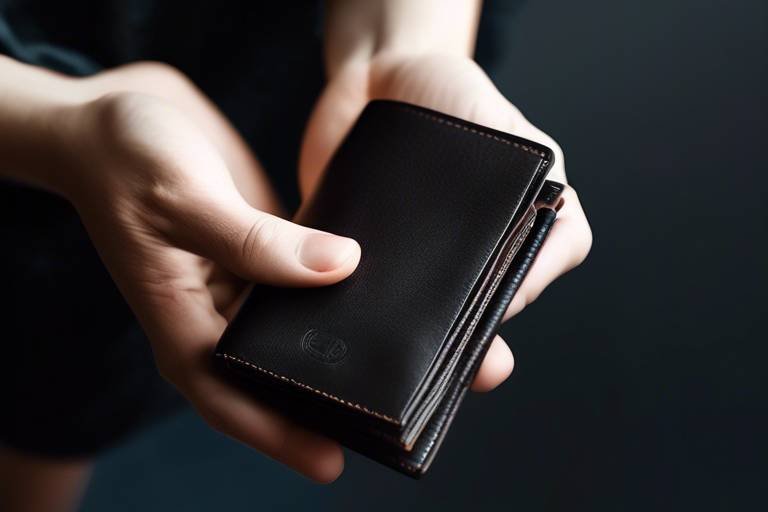The Importance of Wallet Design for User Engagement
In today's digital age, the way we interact with our finances has transformed dramatically. With the rise of digital wallets, the design of these applications is more crucial than ever. Wallet design is not just about aesthetics; it plays a significant role in user engagement, retention, and overall experience. Imagine walking into a store that is beautifully arranged and easy to navigate, versus one that is cluttered and chaotic. Which one would you prefer? Similarly, a well-designed wallet app can make users feel more comfortable and engaged, leading to a better overall experience.
When we talk about wallet design, we are referring to a multitude of factors that contribute to how users interact with the application. From intuitive navigation to visually appealing aesthetics, each element works together to create a seamless user journey. In this article, we will explore the critical aspects of wallet design that enhance user engagement and retention. By understanding these principles, developers and designers can create wallet applications that not only meet user needs but also exceed their expectations.
Furthermore, as we delve into the various components of wallet design, we'll uncover how each aspect can either draw users in or push them away. Think of it like a first date; if everything goes smoothly, you're likely to want a second one. However, if the experience is awkward or uncomfortable, it's probably the last time you'll meet. In the same way, a poorly designed wallet app can lead to frustration and abandonment, while a well-executed design can foster loyalty and frequent use.
Ultimately, the importance of wallet design cannot be overstated. It serves as the foundation for user engagement, impacting everything from how users perceive security to how easily they can navigate through the app. As we continue to explore this topic, keep in mind that a successful wallet design is not just about looking good; it's about creating an experience that resonates with users on multiple levels.
Understanding user experience principles is crucial for wallet design. A great user experience is akin to a well-orchestrated symphony where every note contributes to a beautiful melody. In the context of wallet design, this means considering factors like usability, accessibility, and emotional impact. These core elements enhance usability and contribute to a seamless user journey.
Visual aesthetics play an essential role in wallet design. The colors, typography, and imagery you choose can significantly influence how users perceive and engage with your app. Think of it as dressing for an occasion; the right outfit can make a lasting impression. Similarly, a visually appealing wallet can captivate users and encourage them to explore further.
Color psychology affects user emotions and decisions. For instance, blue is often associated with trust and security, while red can evoke excitement or urgency. By strategically using colors, designers can enhance or detract from user engagement in wallet applications. Imagine a wallet app that uses calming colors to instill a sense of safety while making transactions—this can significantly improve user trust and retention.
Typography choices impact readability and user comfort. Using the right fonts can make a world of difference in how users interact with the wallet interface. A clean, modern font can enhance readability, making it easier for users to navigate through their financial information. On the other hand, overly decorative fonts can create confusion and frustration. It's like choosing between a friendly, approachable font versus a complicated, formal script—one invites conversation, while the other may leave users scratching their heads.
Effective iconography and imagery can enhance user interaction. Well-designed icons serve as visual cues that guide users through the wallet experience, while relevant images can evoke emotions and create connections. Imagine a wallet app that uses intuitive icons that users can instantly recognize—this not only makes the app more engaging but also fosters a sense of familiarity.
A well-organized navigation and layout are vital for user engagement. A cluttered interface can overwhelm users, while a clean, structured layout can facilitate ease of use. Imagine trying to find your way in a maze versus a straight path—one is frustrating, while the other is straightforward. By implementing best practices for structuring wallet interfaces, designers can create an environment where users feel comfortable and confident.
Security features are paramount in wallet design. In a world where digital threats are prevalent, users need to feel secure when managing their finances. Visible security measures, such as two-factor authentication and encryption, can significantly increase user trust and engagement in digital wallets. It's like having a strong lock on your front door; it reassures you that your valuables are safe.
Educating users about security features enhances confidence. This can be achieved through informative pop-ups, tutorials, and FAQs that explain how security protocols work. By empowering users with knowledge, you create a sense of ownership and trust in the wallet application.
Finding the right balance between security and usability is essential. While robust security measures are necessary, they shouldn't come at the expense of user experience. Imagine having to solve a complex puzzle every time you wanted to access your wallet—frustrating, right? By ensuring that security features are user-friendly, designers can create a wallet experience that is both safe and enjoyable.
User feedback is vital for continuous improvement. Just as a chef tastes their dish before serving, developers should gather user insights to refine wallet design. Incorporating user feedback can lead to enhancements that boost engagement and satisfaction.
Usability testing provides critical insights into user behavior. By observing real users interacting with the wallet application, designers can identify pain points and areas for improvement. This iterative process is essential for creating a wallet that meets user needs effectively.
Creating feedback loops encourages ongoing user engagement. By implementing systems for gathering and acting on user feedback, designers can foster a sense of community and connection. Users are more likely to stay engaged with an app that evolves based on their input.
- What are the key elements of wallet design? The key elements include user experience principles, visual aesthetics, security features, and user feedback.
- How does color psychology affect user engagement? Colors can evoke emotions and influence user decisions, impacting their overall experience with the wallet app.
- Why is user feedback important? User feedback helps identify pain points and areas for improvement, ensuring the app meets user needs effectively.

User Experience Principles
Understanding user experience principles is crucial for wallet design. Imagine walking into a store where everything is neatly organized, and you can easily find what you need. This is the kind of seamless journey users expect from digital wallets. When designing a wallet, it’s essential to focus on several core elements that enhance usability. These elements include clarity, consistency, and feedback.
Clarity is all about making the wallet intuitive. Users should be able to navigate through the app without feeling lost or confused. This means using familiar icons and straightforward language. If a user has to think hard about where to click next, you risk losing their engagement. A clear layout helps users know what actions they can take, such as sending money, checking balances, or accessing transaction history.
Consistency is another vital principle. Just like a well-written book follows a consistent style, your wallet design should maintain uniformity in colors, fonts, and button styles. This not only helps in creating a cohesive look but also reinforces user familiarity. Users are more likely to engage with a wallet that feels familiar and predictable, as it reduces their cognitive load and makes interactions smoother.
Feedback is the principle that tells users their actions have been acknowledged. When a user clicks a button, they should receive immediate feedback, whether it’s a visual change, a sound, or a message confirming their action. For instance, if a user successfully completes a transaction, a simple pop-up saying "Transaction Successful!" can enhance their confidence in using the wallet. This feedback loop is crucial for keeping users engaged and informed throughout their journey.
To further illustrate these principles, consider the following table that outlines how each principle contributes to user engagement:
| Principle | Impact on User Engagement |
|---|---|
| Clarity | Reduces confusion, making it easier for users to navigate and complete tasks. |
| Consistency | Builds user trust and familiarity, encouraging them to return and use the wallet regularly. |
| Feedback | Enhances user confidence by confirming actions, leading to a more satisfying experience. |
Incorporating these user experience principles into wallet design is not just about aesthetics; it’s about creating a holistic experience that resonates with users. When users feel comfortable and confident in navigating your wallet, they are more likely to engage with it regularly, leading to higher retention rates and overall satisfaction.
Ultimately, the goal is to create a wallet that feels like a trusted companion rather than a chore to use. By focusing on clarity, consistency, and feedback, designers can create digital wallets that not only meet user needs but also exceed expectations, fostering a loyal user base.

When it comes to wallet design, visual aesthetics are not just about looking pretty; they are about creating an emotional connection with users. Imagine walking into a store that’s beautifully arranged, with colors that soothe your mind and products that catch your eye. That’s the kind of experience a well-designed digital wallet should provide. The first impression counts, and the visual elements of a wallet can either draw users in or push them away. This section dives into how color schemes, typography, and imagery can significantly influence user perception, engagement, and ultimately, the success of a digital wallet.
Let’s start with color schemes. Colors are powerful; they evoke emotions and can influence decisions. For instance, a wallet that uses vibrant colors might attract a younger audience, while muted tones may appeal to a more mature demographic. The right palette can make users feel secure, excited, or even calm. To illustrate this, consider the following table that highlights common colors and their associated emotions:
| Color | Emotion | Application |
|---|---|---|
| Blue | Trust | Banking and Finance |
| Green | Growth | Investment Apps |
| Red | Urgency | Limited Time Offers |
| Yellow | Optimism | Promotional Campaigns |
Next up is typography. The fonts you choose can make or break the readability of your wallet interface. A sleek, modern font can convey innovation, while a classic serif font might evoke tradition and reliability. It’s crucial to strike a balance between style and legibility. Users should be able to quickly read their transaction details without squinting or getting frustrated. Think about it: would you trust a wallet that looks cluttered and confusing? Probably not! Therefore, investing time in selecting the right typography is essential for creating an engaging user experience.
Finally, let’s not forget about iconography and imagery. Icons are like the visual shortcuts that guide users through their journey. A well-designed icon can convey meaning instantly, enhancing the overall usability of the wallet. For instance, a lock icon might symbolize security, while a dollar sign could represent transactions. Imagery also plays a significant role; high-quality images can create a sense of authenticity and professionalism. Users are more likely to engage with a wallet that feels polished and visually appealing. So, make sure your icons are intuitive and your images are relevant!
In conclusion, the visual aesthetics of a wallet are not merely decorative; they are a vital part of the user experience. By carefully considering color schemes, typography, and iconography, wallet designers can create an engaging and memorable experience that keeps users coming back for more. After all, in a world where first impressions matter, a visually appealing wallet can be the difference between a user who stays loyal and one who clicks away.

Color psychology is a fascinating field that delves into how colors influence our emotions and behaviors. When it comes to wallet design, the choice of color can significantly impact user engagement and satisfaction. Imagine walking into a room painted in calming blues versus one drenched in fiery reds; the atmosphere and your emotional response can vary dramatically. Similarly, the colors used in a digital wallet can evoke feelings of trust, excitement, or even anxiety, which ultimately shapes the user experience.
For instance, blue is often associated with trust and security, making it a popular choice for financial applications. Users tend to feel more at ease when they see blue hues, which can enhance their willingness to engage with the wallet. On the other hand, colors like red can create a sense of urgency or alertness, which might be useful for notifications or warnings but could be overwhelming if overused. Therefore, striking the right balance is crucial.
To better understand how different colors affect user perception, let’s explore some common associations:
| Color | Emotional Association | Usage in Wallet Design |
|---|---|---|
| Blue | Trust, security | Backgrounds, buttons |
| Green | Growth, prosperity | Transaction success messages |
| Red | Urgency, caution | Error messages, alerts |
| Yellow | Optimism, attention | Call-to-action buttons |
When designing a wallet interface, it’s essential to consider how these color choices will interact with the overall user experience. For example, using a green color scheme for successful transactions can reinforce positive feelings, while a red alert for failed transactions can effectively grab the user's attention. However, if the palette is too aggressive or jarring, it might lead to user frustration and disengagement.
Moreover, cultural differences can also play a significant role in how colors are perceived. In some cultures, white is associated with purity and peace, while in others, it may symbolize mourning. Therefore, understanding your target audience and their cultural context is crucial when selecting a color palette for your wallet design.
In conclusion, color psychology is not just about aesthetics; it’s about creating an emotional connection with users. By thoughtfully choosing colors that align with the desired user experience, wallet designers can foster a sense of trust and engagement, making users feel more comfortable navigating their financial transactions. So, next time you’re revamping your wallet interface, remember the power of color!

When it comes to wallet design, typography choices are more than just a matter of aesthetics; they are a vital component that can significantly influence user engagement. Imagine opening a digital wallet app and being immediately greeted by a font that is not only visually appealing but also easy to read. This first impression can set the tone for the entire user experience. The right typography can create a sense of familiarity and comfort, while poor choices can lead to frustration and disengagement.
One of the key aspects of typography in wallet design is readability. Users should be able to quickly scan information without straining their eyes. A well-chosen font size and style can make all the difference. For example, sans-serif fonts like Arial or Helvetica are often preferred for digital interfaces because they tend to be cleaner and more legible on screens. In contrast, intricate serif fonts might look great in print but can be challenging to read on a mobile device.
Moreover, font hierarchy plays a crucial role in guiding users through the wallet's features. By using different font sizes, weights, and styles, designers can create a visual hierarchy that directs attention to the most important information. For instance, transaction amounts could be displayed in a bold, larger font, while secondary information, like dates or transaction details, could be in a lighter weight. This approach not only enhances usability but also improves the overall aesthetics of the interface.
Another important factor to consider is brand consistency. The typography used in a wallet app should align with the brand's identity. This means selecting fonts that resonate with the brand's values and target audience. For example, a wallet designed for a tech-savvy, younger audience might opt for modern, trendy fonts, while a more traditional finance app might choose classic, elegant typography. Consistency in typography helps reinforce brand recognition and trust, making users feel more connected to the product.
Finally, it's essential to ensure that typography choices are accessible to all users. This includes considering users with visual impairments who might rely on screen readers or have difficulty reading small text. Providing options for adjusting text size or using high-contrast colors can make a significant difference in creating an inclusive wallet experience.
In conclusion, typography choices in wallet design are not to be overlooked. They are a powerful tool that can enhance readability, establish brand identity, and improve overall user experience. By paying attention to these details, designers can create a wallet interface that not only captivates users but also keeps them engaged and coming back for more.
- What is the best font size for wallet applications? Generally, a font size between 14px and 18px is recommended for body text to ensure readability on mobile devices.
- How can I ensure my wallet design is accessible? Use high-contrast colors, provide options for text resizing, and choose fonts that are easy to read for users with visual impairments.
- Is it important to stick to one font family? While consistency is key, using a combination of two or three complementary fonts can enhance the design without overwhelming the user.

When it comes to wallet design, iconography and imagery are like the unsung heroes that can either make or break user engagement. Think about it: when you open a wallet app, what catches your eye first? It’s often the icons and images that create an immediate impression. A well-designed icon can communicate functionality at a glance, while the right imagery can evoke emotions that keep users coming back. This is why it's crucial to invest time in crafting these visual elements.
Let’s dive deeper into how effective iconography and imagery can enhance user interaction. First off, icons should be intuitive and recognizable. Users shouldn’t have to guess what a symbol means; it should be immediately clear. For instance, a wallet icon that looks like a traditional wallet will resonate more with users than an abstract representation. It’s all about creating a sense of familiarity. Additionally, using consistent icon styles throughout the application helps to create a cohesive experience, making navigation feel seamless.
Now, imagery plays a different yet equally important role. High-quality images can set the tone for the entire wallet experience. For example, a background image that reflects trust and security can make users feel more comfortable about using the app for sensitive transactions. Moreover, images can also be used to highlight features or promotions within the wallet. This is where you can get a bit creative! Think about using vibrant images that tell a story or convey a message about what your wallet can do for the user.
To illustrate this, consider the following table that summarizes the impact of effective iconography and imagery:
| Element | Impact on User Engagement |
|---|---|
| Intuitive Icons | Enhance usability and reduce confusion |
| Consistent Icon Styles | Create a cohesive user experience |
| High-Quality Imagery | Set the tone and evoke trust |
| Storytelling Images | Engage users emotionally and promote features |
In conclusion, the thoughtful application of iconography and imagery in wallet design can significantly elevate user experience. It’s not just about making things look pretty; it’s about creating an environment that feels inviting and secure. So, take a moment to evaluate your wallet design. Are your icons intuitive? Is your imagery compelling? If not, it might be time for a redesign.
- What is the importance of iconography in wallet design? Iconography helps users navigate the app easily by providing clear visual cues.
- How can imagery influence user engagement? Well-chosen images can evoke emotions, establish trust, and enhance the overall aesthetic of the wallet.
- What are some best practices for selecting icons? Icons should be intuitive, consistent in style, and relevant to the functionality they represent.
- Can I use stock images for my wallet app? While stock images can be used, custom images often resonate better with users and enhance brand identity.

When it comes to wallet design, navigation and layout are not just afterthoughts; they are the backbone of user engagement. Imagine walking into a store where everything is scattered around—frustrating, right? The same principle applies to digital wallets. A well-structured layout allows users to find what they need quickly and efficiently, enhancing their overall experience. Think of your wallet interface as a well-organized toolbox: when everything is in its place, you can easily grab the tool you need without fumbling around.
To create a seamless navigation experience, designers should focus on a few key elements:
- Intuitive Menu Structures: Users should be able to navigate through options without a second thought. Consider using a hamburger menu or tabs that clearly label each section, allowing users to jump to their desired area with ease.
- Consistent Design Patterns: Consistency breeds familiarity. By maintaining uniformity in button shapes, colors, and fonts across the wallet interface, users will feel more comfortable and confident as they explore.
- Responsive Design: With users accessing wallets on various devices, a responsive layout that adjusts to different screen sizes is crucial. A design that looks great on a smartphone should also be functional on a tablet or desktop.
Moreover, the layout should be designed with the user’s journey in mind. For instance, placing frequently used features like transaction history or payment options in easily accessible locations can significantly reduce the time users spend searching for them. Think of it as placing your keys in a designated spot every time you come home—eventually, it becomes second nature.
Another vital aspect is the use of whitespace. A cluttered interface can overwhelm users, leading to frustration and disengagement. By incorporating ample whitespace, you can create a clean and inviting interface that guides users' eyes to the most important elements. This is akin to a well-plated dish—too many ingredients can spoil the presentation, while a balanced arrangement makes it visually appealing.
In summary, effective navigation and layout are paramount for engaging users in digital wallets. By focusing on intuitive structures, consistency, responsiveness, and the strategic use of whitespace, designers can create an environment that not only attracts users but keeps them coming back. After all, a user-friendly wallet is not just about functionality; it’s about creating a delightful experience that users will want to revisit time and again.
Q: Why is navigation important in wallet design?
A: Navigation is crucial because it directly impacts the user's ability to interact with the wallet. A well-designed navigation system enhances usability and encourages users to engage with the features offered.
Q: How can I ensure my wallet layout is user-friendly?
A: To ensure a user-friendly wallet layout, focus on intuitive menu structures, maintain consistent design patterns, and incorporate responsive design that adapts to various devices.
Q: What role does whitespace play in wallet design?
A: Whitespace helps to reduce clutter and improves readability, making the interface more inviting and easier for users to navigate.

When it comes to wallet design, security features are not just an afterthought; they are the backbone that supports user trust and engagement. Imagine walking into a bank with no security measures in place—would you feel comfortable leaving your hard-earned money there? Similarly, digital wallets must prioritize security to ensure users feel safe while managing their finances online. A well-designed wallet incorporates visible security features that reassure users, making them more likely to engage and remain loyal to the platform.
One of the most effective ways to enhance user trust is through the implementation of multi-factor authentication (MFA). This can be likened to having a double lock on your front door; it adds an extra layer of protection. Users are generally more inclined to use a wallet that requires multiple forms of verification, such as a password combined with a fingerprint or facial recognition. This not only protects their data but also enhances their overall experience, as they feel more secure while navigating the app.
Moreover, the way security features are presented can significantly influence user perception. Instead of burying security protocols in the depths of the app’s settings, designers should make them prominent. A security dashboard could serve as a central hub where users can easily access information about their security settings, recent activity, and any alerts. This transparency fosters a sense of control, allowing users to feel empowered rather than anxious about potential threats. A table summarizing key security features could also be beneficial:
| Security Feature | Description | User Benefit |
|---|---|---|
| Multi-Factor Authentication | Requires multiple forms of verification | Enhanced security and peace of mind |
| Encryption | Secures user data through advanced algorithms | Protection against data breaches |
| Real-Time Alerts | Notifies users of suspicious activity | Immediate awareness and action |
In addition to these features, educating users about security measures is crucial. Many users may not fully understand how their data is protected or the importance of certain security features. By providing clear and concise information, possibly through pop-up tips or a dedicated FAQ section, wallets can demystify security protocols. This not only enhances user confidence but also encourages them to actively engage with the security features available to them.
However, implementing robust security measures shouldn't come at the cost of usability. Striking the right balance is essential. If a wallet is too cumbersome to use due to excessive security checks, users may abandon it altogether. Therefore, designers must ensure that security features are seamlessly integrated into the user experience. For instance, a smooth transition between security checks can make the process feel less intrusive, thereby enhancing user satisfaction.
Ultimately, the effectiveness of security features in wallet design lies in their ability to foster trust and engagement. When users feel secure, they are more likely to explore the full range of functionalities offered by the wallet, leading to higher retention rates and a more vibrant user community. As we continue to navigate the digital landscape, the importance of security in wallet design cannot be overstated—it's not just about protecting data; it's about creating a safe haven for users in an increasingly complex world.
Q: How can I ensure my digital wallet is secure?
A: Always enable multi-factor authentication, use strong passwords, and keep your app updated to protect against vulnerabilities.
Q: What should I do if I suspect unauthorized access to my wallet?
A: Immediately change your password, enable security alerts, and contact customer support for assistance.
Q: Are security features in digital wallets regulated?
A: Yes, many regions have regulations that require digital wallets to adhere to strict security standards to protect user data.

In the digital age, where transactions happen at the click of a button, user education on security has become more important than ever. Imagine handing someone a key to your house without explaining how to use it safely. That's what it feels like when users are not adequately informed about the security features of their digital wallets. To create a trustworthy environment, wallet developers must prioritize educating users about the security measures in place. This can significantly enhance user confidence and engagement.
When users understand how to protect themselves and their assets, they are more likely to engage with the wallet regularly. This education can take various forms, including tutorials, FAQs, and interactive guides. For instance, a simple walkthrough that explains how to enable two-factor authentication can demystify the process and encourage users to take advantage of this essential feature. Additionally, incorporating visual aids such as infographics can help users grasp complex concepts quickly and efficiently.
Furthermore, it's crucial to communicate the importance of security in a relatable manner. Users are more likely to remember information when it resonates with them personally. For example, instead of just stating that a strong password is necessary, developers could highlight the risks associated with weak passwords by sharing stories or statistics that demonstrate the consequences of poor security practices. This approach not only informs but also motivates users to take action.
To further enhance user understanding, wallet applications can implement features that allow users to test their knowledge about security protocols. For example, a small quiz after a tutorial could reinforce what users have learned and provide instant feedback. This interactive element can make learning about security feel less like a chore and more like a valuable part of the user experience.
Ultimately, the goal of user education on security is to create a community of informed users who feel empowered to use their wallets safely. By investing in user education, wallet providers not only build trust but also foster a loyal user base that understands and appreciates the value of security. This, in turn, leads to higher engagement rates and a more robust digital wallet ecosystem.
- Why is user education on security important?
User education is crucial as it helps users understand how to protect their assets and enhances their confidence in using the wallet.
- What methods can be used for user education?
Methods include tutorials, FAQs, interactive guides, and quizzes that reinforce learning.
- How can developers make security education relatable?
By using stories or statistics that highlight the risks associated with poor security practices.
- What role do visual aids play in user education?
Visual aids like infographics can simplify complex concepts and make them easier to understand.

In the digital age, where security breaches are as common as morning coffee, finding the sweet spot between security and usability in wallet design is crucial. Imagine a vault door that’s so heavy and complex that no one can open it. Sure, it’s secure, but if no one can access their money, what’s the point? This dilemma highlights the importance of crafting a wallet experience that feels safe yet remains user-friendly.
First and foremost, wallet designers must recognize that users value convenience. If a wallet application is overly complicated or requires multiple steps to access funds, users may abandon it for a simpler option. Therefore, implementing security features should not come at the cost of making the wallet cumbersome. For instance, consider the use of biometric authentication, such as fingerprint or facial recognition, which provides robust security while allowing users to access their wallets quickly. This method combines high-level security with an intuitive user experience, making it a win-win situation.
Moreover, educating users about the security measures in place is essential. When users understand the benefits of security features, they are more likely to appreciate them rather than view them as obstacles. For example, a wallet application can include brief tutorials or pop-up messages that explain how encryption protects their data, or how two-factor authentication adds an extra layer of safety. This knowledge empowers users, making them feel more secure and engaged with the application.
Another strategy for balancing security and usability involves the use of progressive security measures. This means that the level of security can adjust based on the user’s activity. For instance, simple transactions might only require a PIN, while larger transactions could trigger additional verification steps. This layered approach ensures that users enjoy a seamless experience for everyday tasks while maintaining stringent security for more sensitive actions. It’s akin to having a sturdy lock on your front door but leaving the window open for fresh air when you’re home.
To illustrate this balance, consider the following table that summarizes key strategies for achieving security without sacrificing usability:
| Strategy | Security Benefit | User Experience Impact |
|---|---|---|
| Biometric Authentication | High-level security with quick access | Enhanced convenience and speed |
| Educational Pop-ups | Informs users about security measures | Increased trust and engagement |
| Progressive Security Measures | Adjustable security based on risk | Seamless experience for low-risk actions |
Ultimately, the goal of any wallet design should be to create a harmonious relationship between security and usability. When users feel secure, they are more likely to engage with the wallet regularly, leading to better retention and satisfaction. It’s about building a digital environment where users can confidently manage their finances without feeling overwhelmed by security protocols. In the end, a well-balanced wallet design not only protects users but also enhances their overall experience, making them feel valued and understood.
- What is the most important aspect of wallet design? The most important aspect is achieving a balance between security and usability, ensuring users can easily access their funds while feeling secure.
- How can biometric authentication enhance user experience? Biometric authentication speeds up the login process while providing a high level of security, making it convenient for users.
- Why is user education on security features important? Educating users builds trust and understanding, making them more likely to engage with the wallet application.
- What are progressive security measures? These are adjustable security protocols that change based on the user's activity, allowing for a seamless experience during low-risk transactions.

In the rapidly evolving world of digital wallets, user feedback is not just a nice-to-have; it’s a necessity. Think of it as the compass that guides your design decisions, ensuring you’re heading in the right direction. User feedback provides critical insights that can help you understand what your users truly want and need. By actively listening to your audience, you can refine your wallet design to enhance engagement and satisfaction. This iterative process is akin to a sculptor chiseling away at a block of marble—each piece of feedback helps you reveal a more refined and user-friendly product.
One of the most effective ways to gather user feedback is through usability testing. This involves observing real users as they interact with your wallet application. You can gain invaluable insights into their behavior, preferences, and pain points. For instance, during a usability test, you might notice users struggling to find a specific feature or becoming frustrated with the navigation. Such observations can highlight areas that need improvement and help you prioritize changes that will have the most significant impact on user experience.
Additionally, implementing feedback loops is crucial for maintaining ongoing user engagement. This means creating mechanisms for users to voice their opinions continuously, whether through surveys, feedback forms, or in-app prompts. By encouraging users to share their thoughts, you not only gain insights but also foster a sense of community and ownership among your users. They feel valued, knowing that their opinions can shape the future of the wallet they use. Consider integrating a simple feedback form directly into your app, allowing users to report issues or suggest enhancements without any hassle.
Moreover, it's essential to analyze the feedback you receive systematically. You can categorize feedback into themes or issues, which allows you to identify trends over time. For example, if multiple users express difficulty in accessing certain features, it might be time to reconsider how those features are displayed or organized within the app. A
| Feedback Theme | Action Item |
|---|---|
| Navigation Issues | Redesign the menu layout for better accessibility |
| Security Concerns | Enhance visibility of security features |
| Feature Requests | Prioritize development of requested features |
Finally, remember that the process of gathering and implementing user feedback is ongoing. As user needs evolve, so should your wallet design. Regularly revisiting and refining your application based on user insights ensures that you remain relevant and competitive in the market. This iterative approach not only enhances user engagement but also builds a loyal user base that feels connected to your brand.
- How can I effectively gather user feedback?
Utilize surveys, usability testing, and in-app feedback forms to collect insights from your users.
- What should I do with the feedback I receive?
Analyze the feedback, categorize it, and implement changes based on common themes or issues.
- How often should I update my wallet based on user feedback?
Regularly review feedback and make updates as needed, ideally at least once every few months.

Usability testing is an essential step in the design process of digital wallets, as it provides invaluable insights into how real users interact with your application. Imagine you're crafting a beautiful, intricate puzzle, but without testing, you might not realize that some pieces just don't fit. That's where usability testing comes in—it helps you identify those mismatched pieces before your users get frustrated and walk away. By observing users as they navigate your wallet application, you can uncover pain points, confusion, and areas of delight that you may have overlooked during the design phase.
When conducting usability tests, it's crucial to create a comfortable environment for your participants. This means ensuring they feel at ease to express their thoughts and frustrations openly. You might want to consider using a mix of moderated and unmoderated testing sessions. In moderated sessions, you guide users through specific tasks while observing their behavior and asking questions. Unmoderated sessions, on the other hand, allow users to explore the wallet at their own pace, providing insights into their natural interactions. Both methods have their merits, and utilizing a combination can yield a comprehensive understanding of user behavior.
As you prepare for usability testing, here are some key elements to keep in mind:
- Define Clear Objectives: What specific aspects of the wallet do you want to test? Are you focusing on navigation, security features, or the overall aesthetic? Having clear goals will help you design effective tasks for users.
- Select the Right Participants: Choose a diverse group of users that represent your target audience. This diversity will help you gather a wider range of feedback and insights.
- Create Realistic Scenarios: Design tasks that mimic real-life situations users would face when using the wallet. This approach ensures that the feedback you gather is relevant and actionable.
After conducting the tests, it's time to analyze the data you've collected. Look for patterns in user behavior and note any recurring issues. This analysis will guide you in making informed design decisions. For instance, if multiple users struggle with a specific feature, it may indicate a need for redesign or clearer instructions.
Finally, don't forget to iterate based on the feedback. Usability testing is not a one-time event; it's part of an ongoing cycle of improvement. By continuously refining your wallet's design based on user insights, you can enhance engagement and satisfaction, ultimately leading to a more successful product. Remember, the goal is to create a wallet that feels intuitive and enjoyable to use, making your users feel confident and secure in their transactions.
- What is usability testing?
Usability testing is a method used to evaluate a product by testing it with real users. It helps identify usability issues and areas for improvement. - How often should I conduct usability tests?
It's advisable to conduct usability tests at various stages of the design process, especially after major updates or redesigns. - What tools can I use for usability testing?
There are several tools available, such as UserTesting, Lookback, and Optimal Workshop, which can facilitate remote or in-person usability testing.

Creating feedback loops in digital wallet applications is essential for fostering a continuous dialogue between users and developers. Think of it as a two-way street where both sides can express their needs and concerns, ultimately leading to a more engaging user experience. By actively seeking out user feedback, wallet designers can identify pain points, understand user preferences, and implement changes that resonate with their audience. This process not only enhances user satisfaction but also builds a sense of community and trust around the product.
To effectively implement feedback loops, consider the following strategies:
- In-App Surveys: Integrating short surveys within the wallet application allows users to provide feedback without leaving the app. These surveys can be strategically placed after key interactions, such as completing a transaction or updating their profile.
- User Interviews: Conducting one-on-one interviews with users can provide deep insights into their experiences and expectations. This qualitative data can be invaluable for understanding the nuances of user behavior.
- Feedback Buttons: Adding a simple feedback button on the wallet interface encourages users to share their thoughts instantly. This feature should be easily accessible, allowing users to report issues or suggest improvements without any hassle.
Once feedback is collected, it’s crucial to analyze and categorize the responses. This can be done through the following methods:
| Feedback Type | Description | Actionable Steps |
|---|---|---|
| Bug Reports | Users report issues or glitches within the app. | Prioritize fixes and release updates. |
| Feature Requests | Users suggest new features or enhancements. | Evaluate feasibility and plan for future updates. |
| General Feedback | Users share their overall experience and suggestions. | Identify trends and make design adjustments accordingly. |
After analyzing the feedback, the next step is to communicate the changes back to the users. This step is often overlooked but is vital for closing the feedback loop. Users appreciate knowing that their voices are heard, and informing them about the updates made based on their suggestions fosters a sense of ownership and loyalty. You can use in-app notifications, email newsletters, or social media updates to share these improvements.
Moreover, it's essential to create a culture of continuous improvement. Encourage users to keep providing feedback, emphasizing that their input is crucial for the wallet’s evolution. By establishing a routine where user feedback is regularly solicited and acted upon, wallet designers can ensure that their applications remain relevant and user-friendly.
In summary, implementing feedback loops is not just about collecting data; it’s about creating a dynamic relationship with users that drives engagement and satisfaction. By actively listening to users, analyzing their feedback, and communicating changes, wallet designers can cultivate a product that truly meets the needs of its audience.
- What are feedback loops?
Feedback loops are systems that allow users to provide input on their experiences, which developers can then use to improve the product. - How can I encourage users to give feedback?
You can encourage feedback by integrating surveys, feedback buttons, and conducting user interviews within the app. - Why is user feedback important?
User feedback is crucial for understanding user needs, identifying pain points, and making informed design decisions that enhance user engagement. - How often should I collect feedback?
Regularly collecting feedback, such as after significant updates or new feature releases, helps maintain an ongoing dialogue with users.
Frequently Asked Questions
- What are the key principles of user experience in wallet design?
User experience in wallet design revolves around core principles such as usability, accessibility, and efficiency. These elements ensure that users can navigate the wallet easily, access features without confusion, and complete transactions quickly. A well-designed wallet minimizes friction and enhances satisfaction, making it crucial for user retention.
- How does visual aesthetics influence user engagement?
Visual aesthetics significantly affect how users perceive and interact with a wallet. Color schemes can evoke emotions, typography affects readability, and imagery can enhance the overall appeal. A visually pleasing wallet can draw users in and keep them engaged, making it essential for designers to pay attention to these elements.
- What role does color psychology play in wallet design?
Color psychology is all about how colors influence user emotions and decisions. For instance, blue often conveys trust, while red can create urgency. By strategically using colors, wallet designers can evoke specific feelings that enhance user engagement and guide users toward desired actions.
- Why is security important in wallet design?
Security is paramount in wallet design because users need to trust that their financial information is safe. Visible security features, such as encryption icons or two-factor authentication prompts, can reassure users and enhance their engagement. A wallet that prioritizes security can significantly improve user confidence and loyalty.
- How can user feedback improve wallet design?
User feedback is a goldmine for continuous improvement. By conducting usability testing and gathering insights, designers can identify pain points and areas for enhancement. Implementing feedback loops allows for ongoing adjustments, ensuring that the wallet evolves according to user needs, which ultimately boosts engagement and satisfaction.
- What are effective methods for conducting usability testing?
Effective usability testing can include methods such as user interviews, A/B testing, and observational studies. These techniques provide valuable insights into how real users interact with the wallet, highlighting areas that may need refinement. By observing users in action, designers can make informed decisions that enhance the overall user experience.



















